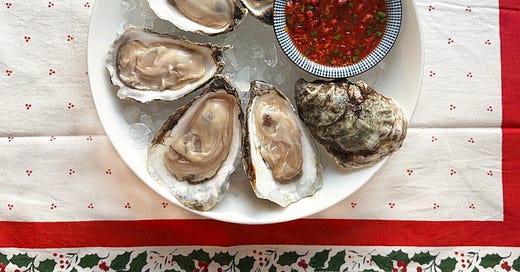Oysters for Dinner
Learn to shuck, and you can eat like a king—or an 18th century street vendor.
For more quick-and-easy (and delicious!) meals, pre-order a copy of my upcoming book SNACKING DINNERS! As a bonus, I’ll happily send you a free signed bookplate made out to whomever you like and sign you up for fun prize drawings. (Pre-orders are a huge boost for Amazon rankings and encourage indie bookstores to stock the book.)
(Quick Note: This newsletter is brand new—if you like it, please subscribe, share with a friend, or hit the “like” button below to help me build my audience!)
An icy plate of oysters on the half shell might seem like the height of sophistication—something you’d pay an arm and a leg for at a fancy restaurant—but 150 years ago (and earlier), oysters were food for the common person (ie, me). These briny bivalves were so abundant that in New York City they were sold from street carts, and in San Francisco gold-seeking miners foraged for them in the waters of the bay. (The shellmounds left by local Native groups show that they were an abundant resource in Northern California, where I live, for centuries.)
The thing is, oysters still don’t have to be wildly expensive if you buy them directly from the oyster farm or a good fishmonger. Hog Island, in Marin, sells a dozen extra-small sweetwaters for just $22 at their outpost on the coast; Mere Point in Maine sells two dozen “petits” for $40; Seattle’s Pike Place fish market has a dozen medium Pacific oysters for just $18.99. If you’re only buying enough for yourself (or for yourself and one other person), that’s not bad as far as fancy meals go.
So, this time of year, when the family is out and I want something festive and celebratory all for myself, I grab a couple dozen oysters and turn them into dinner.
The key, of course, is that to eat oysters a home, you have to learn to shuck them. Fortunately, it’s not actually that hard—while it can be nerve wracking at first and requires a little bit of skill (plus the proper knife), once you’ve popped a few oysters open, you’ll easily get the hang of it. I was lucky enough to learn how to do this from an award-winning oyster shucker (back when I was an editor at Saveur magazine), and the skill has served me well, even if I only use it once or twice a year. I’ve made a little video, below, of how I opened the highwaters pictured above. (They were actually particularly tricky, because of their shape, but opened fine with a little extra care.) You can also find plenty of other tutorials online. And if you’re really nervous about it, you can get a specialized oyster shucking glove, to wear on the hand that holds the oyster, to keep from accidentally stabbing yourself (though in 15 years I’ve never once had this happen).
Once you have that part down, you don’t really need anything more than a wedge of lemon—and maybe a crisp martini or glass of bubbly—but I like to make a quick mignonette to add some acid and flavor to my oysters. A basic mince of shallot with vinegar is great, but when I can, I add some citrus zest, fresh herbs, or even minced fruit to the mix to make something fun. Here, I’ve combined tangerines and pomegranate; the flavors are lovely with the briny oysters, and the combo looks fun and festive.
I prefer using tiny, sweet kishu tangerines—their flavor is fantastic, and I’ll take as many as I can get this time of year—but if you can’t find them, use half of another type of tangerine or mandarin instead. I also add finely chopped pomegranate arils to my mignonette, seeds and all, because I like the crunch, but you could swap them for a teaspoon of pomegranate juice.
Oysters with Tangerine-Pomegranate Mignonette
Serves 1 for dinner (or 6–12 before dinner)
1 medium kishu tangerine (or similar), washed well
1 generous teaspoon pomegranate arils
½–1 teaspoon champagne vinegar
1 chive, finely chopped
1–2 dozen oysters (or more or less, as you like)
Use a microplane to zest the tangerine into a small bowl. Cut the denuded tangerine in half and squeeze about a tablespoon of the juice into the bowl. Finely chop the pomegranate arils, then use the side of the knife to scoop both the chopped arils and the juice that has pooled on the board into the bowl. Add ½ teaspoon of the vinegar, along with the chive, then taste the mignonette and add more vinegar if you like.
Shuck the oysters (all at once or a few at a time*—see video below) and enjoy with the mignonette.
Bulk Up the Plate: To add a little more heft to the meal, serve your oysters with lots of good bread and butter.
*If you’re going to enjoy the oysters with a drink, do all your shucking before you sip!
This “highwater” oyster was a little tricky to open (the guy at Hog Island warned me it would be), so I set it on the counter instead of holding it in my hand, and I pressed down on the top with the towel so that I could add more force with the knife. If you’re a beginner and you’re nervous, you might like this approach.
Photo and Video: Georgia Freedman




